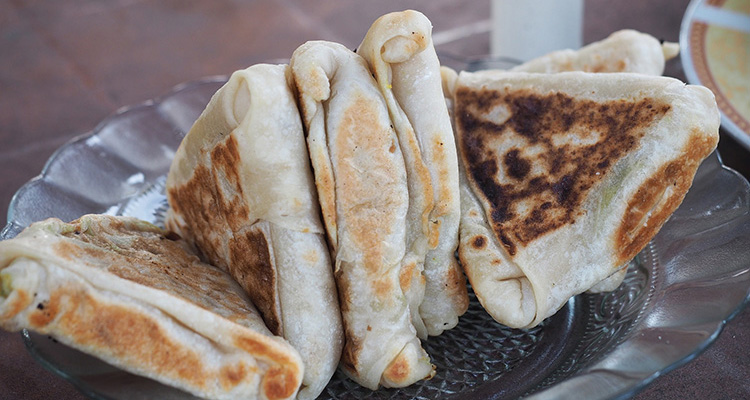Hohhot Baizi: Crispy Mongolian Breakfast Bread
When morning light fills Hohhot’s streets, a warm aroma of wheat and toasted sesame oil rises from neighborhood bakeries. This scent belongs to baizi, a humble yet iconic flatbread unique to Hohhot and Inner Mongolia. More than a breakfast item, baizi is a comfort food and cultural emblem—an ideal first taste for visitors eager to experience local life.
1. Ancient Roots: A Blend of Steppe and Farming Traditions
Baizi’s story reflects Hohhot’s position at the crossroads of grassland and agrarian cultures. Drawing from northern Chinese wheat-baking techniques and local ingredients, baizi evolved into a distinctive flatbread. Its history traces back to the Ming and Qing dynasties; for centuries it has been a staple of daily meals in the old city, carrying generations of memories.
2. Cultural Meaning: The Breakfast ‘Hard Currency’
In Hohhot, baizi holds social importance similar to other regional breakfast icons. A hot baizi paired with milk tea or a bowl of lamb offal soup fuels the day for workers, elders, and students alike. Morning queues at baizi stalls are as much about community as food—trying baizi offers visitors an authentic glimpse into local rhythms and hospitality.

3. Key Ingredients: Simple Components, Rich Aroma
Baizi’s flavor comes from modest, high-quality ingredients. Strong wheat flour from the Hetao Plain gives the interior a soft yet chewy texture. The defining note is local sesame (humax) oil—its nutty aroma intensifies under high heat during baking and forms the bread’s signature crispness. Salt, sugar, fennel seeds, or sesame may be added depending on whether the baizi is savory or sweet.
4. The Making: Skill, Timing, and Heat
A great baizi requires careful control of time and temperature. Bakers mix high-gluten flour, sesame oil, water, and a touch of yeast or leavening, kneading until smooth and allowing the dough to rest. The dough is portioned and shaped—round, tongue-shaped, or triangular—which affects how it cooks. Traditionally, baizi are baked on a specialized griddle or in a hanging oven; bakers flip them repeatedly until both sides turn golden and puff slightly, releasing that irresistible roasted aroma.

5. Flavor and Texture: Crispy Outside, Soft Inside
Fresh from the oven, baizi delights with a crisp crackle and a burst of warm, wheaty aroma. The exterior is brittle and golden; the interior remains tender and elastic. Savory baizi become more aromatic the more you chew; sweet versions balance sugar with sesame oil’s depth. This contrast—crisp versus soft—is what makes baizi memorable.
6. How to Eat: Versatile and Satisfying
Baizi is extremely adaptable:
- Direct tasting: Eat plain to enjoy the pure wheat and sesame flavor.
- Breakfast combo: Tear into pieces and soak in salty milk tea or sandwich with lamb offal or sliced cooked meat for a hearty meal.
- Creative fillings: Locals and younger diners sometimes add fried egg, sausage, or spicy snacks to make a Chinese-style sandwich.
7. Tasting Tips: Eat Like a Local
- Timing matters: try baizi straight from the oven for peak texture and flavor.
- Choose long-standing shops: follow local queues to find authentic bakeries in Hohhot’s Old City.
- Try both savory and sweet to compare flavors.
- Don’t miss classic pairings like baizi with lamb offal soup or baizi soaked in milk tea.

8. Visitor Practicalities: Where, Price, and Packing
- Where to find: Hohhot’s Old City (especially the Muslim quarter, Kuang Alley, and Tongdao Street) hosts many baizi stalls from dawn to dusk.
- Price: Very affordable—usually around RMB 2–5 per piece.
- To-go: Baizi travel well. When cooled they can stiffen; reheat briefly in an oven or skillet to restore crispness.
- Language tip: Ask for “baizi” (Bèi zi) or specify “savory” or “sugar” (sweet).
9. Simple Home Version: Bring the Steppe Flavor Home
Try this simplified home method to recreate baizi:
- Dough: Mix 300g all-purpose flour, 3g yeast, a pinch of sugar and salt, warm water, and a little sesame oil. Knead until smooth and proof until doubled.
- Oil paste: Mix a small amount of flour with hot sesame oil to form a paste.
- Shape: Roll the dough, spread the oil paste, roll up and divide, then flatten into discs. Brush with sugar water and sprinkle sesame if desired.
- Cook: Pan-fry on low-medium heat with a thin layer of oil until both sides are golden and puffed.


